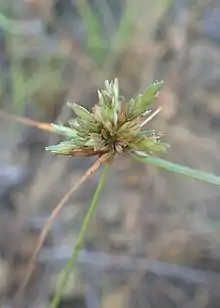| Great Plains flatsedge | |
|---|---|
 | |
| Scientific classification | |
| Kingdom: | Plantae |
| Clade: | Tracheophytes |
| Clade: | Angiosperms |
| Clade: | Monocots |
| Clade: | Commelinids |
| Order: | Poales |
| Family: | Cyperaceae |
| Genus: | Cyperus |
| Species: | C. lupulinus |
| Binomial name | |
| Cyperus lupulinus (Spreng.) Marcks | |
| Synonyms[1] | |
| |
Cyperus lupulinus, the Great Plains flatsedge, is a plant species native to North America. It is widespread across southeastern Canada and the central and northeastern United States as far west as Wyoming, Colorado and New Mexico, with more isolated populations reported in Washington (Asotin County), Idaho (Idaho County) and Oregon (Wallowa County). It grows in open, sun-lit locations such as fields, prairies, roadsides, farms, etc.[2][3]
Description
Cyperus lupulinusis a perennial herb up to 50 cm tall, spreading by means of underground rhizomes. Culms are triangular in cross-section. Spikes are densely clustered into a more or less spherical clump. Achenes are dark brown, almost black, egg-shaped, about 2 mm across.[2][4][5][6][7][8]
Taxonomy
Two subspecies are accepted:[1][2]
- Cyperus lupulinus subsp. lupulinus - Floral scales greater than 2.5 mm, not clasping achenes; spikelets with 5-22 scales each
- Cyperus lupulinus subsp. macilentus (Fernald) Marcks - Floral scales less than 2.5 mm, clasping achenes; spikelets with 3-7 scales each
See also
References
- 1 2 The Plant List
- 1 2 3 Flora of North America, v 23 p 176. Cyperus lupulinus
- ↑ BONAP (Biota of North America Project) floristic synthesis, Cyperus lupulinus
- ↑ Marcks, Brian. 1974. Transactions of the Wisconsin Academy of Sciences, Arts and Letters 62: 271.
- ↑ photo of a herbarium specimen of Cyperus lupulinus at Missouri Botanical Garden, collected in Missouri 1994.
- ↑ Sprengel, Curt Polycarp Joachim. 1807. Mantissa Prima Florae Halensis 1: 30.
- ↑ Great Plains Flora Association. 1986. Flora of the Great Plains i–vii, 1–1392. University Press of Kansas, Lawrence.
- ↑ Wunderlin, R. P. 1998. Guide to the Vascular Plants of Florida i–x, 1–806. University Press of Florida, Gainesville.